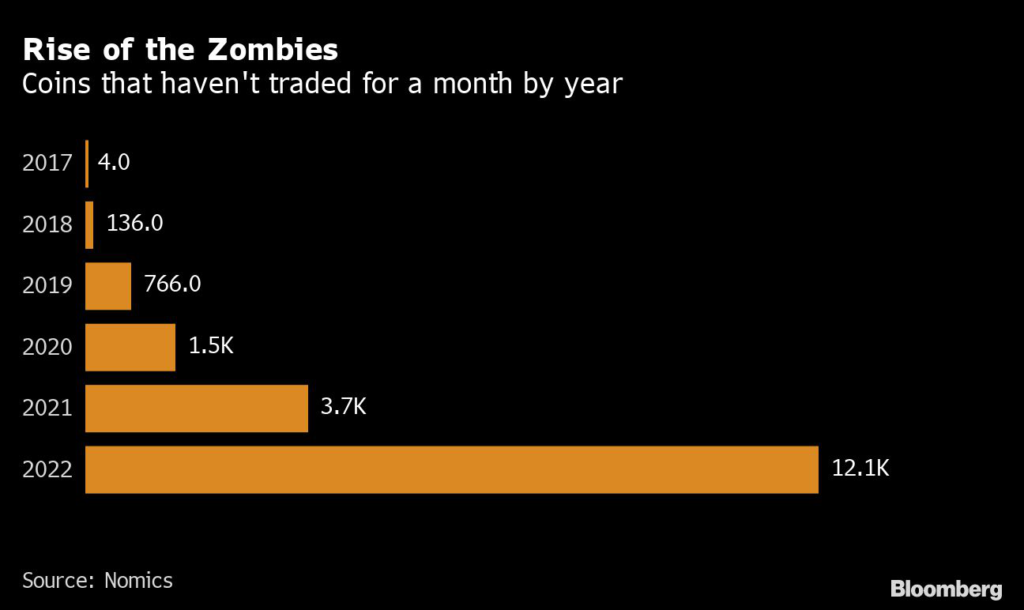A huge amount of digital tokens are languishing as “even good projects” strive to stay afloat in market doldrums that may last for months to come.
(Bloomberg) — When it comes to putting a number on this year’s crypto swoon, the one cited most often is $2 trillion, the amount of digital-asset market value that evaporated in the downdraft. But here’s a figure that captures the breadth of the bear market: 12,100.
That’s the number of crypto tokens that have effectively ceased trading this year, according to data provider Nomics — not dead technically, but like zombies, not quite alive either.
Most blockchain projects are built around bespoke digital coins, which often function as user rewards and compensate developers for their work, giving them incentive to stay involved. During last year’s price run-up, thousands of crypto startups issued new tokens to support these projects, and bullish sentiment meant there was ample demand for the market to absorb the vast majority of them and still drive prices higher.
That all changed this year, as macroeconomic conditions put investors off risk assets and token prices nosedived. The implosion of the Terra blockchain, as well as the collapse of hedge fund Three Arrows Capital and crypto firms like Celsius Network caused a further selloff and cooled venture capital funding. The biggest tokens, like Bitcoin and Ether, suffered major declines before eventually finding support. But for many coins backing fledgling, riskier and sometimes sketchier endeavors, the downturn has delivered the equivalent of a knockout blow.
Nomics compiled an analysis of coin activity for Bloomberg and discovered that more than 12,100 tokens have become “zombies” this year, defined as tokens that have not traded for a month. That’s more than twice as many as in all prior years combined, the researcher found.
“During the bull market of 2021, there was plenty of money, attention, and liquidity for new and existing projects,” Jacob Joseph, a research analyst at researcher CryptoCompare, said in an interview. “However, in the ongoing bear market, even good projects with utility will struggle to sustain their operations as they lose access to capital and funding.”
This contrasts with the bust-up in initial coin offerings that occurred during the previous bear market starting in 2018. Then, startups issued coins — often illegally, it turns out — to raise funding. Most ICOs didn’t even have working prototypes, much less users; when they went under, only investors got burned. And the market was smaller: in 2018, a total of 136 tokens turned into zombies, while 766 coins earned that designation in 2019, far below this year’s level.
It’s difficult to know the scope or seriousness of the projects affected this time around, though a decent chunk are likely memes, short-term leveraged assets, or small personal projects done for fun, according to Nick Gauthier, a co-founder at Nomics. Many, such as a project called BoomSpace, which purported to work on blockchain gaming, no longer have a live website, but only a Twitter account that hasn’t been updated in several months. Elonmoon, a token for a game related to moon exploration, has a warning on tracker CoinMarketCap, “We have received multiple reports that some holders cannot sell their tokens. Please exercise caution and do your own due diligence!”
Even among active coins, trading can be thin. Of the more than 64,400 assets Nomics tracks, only about 13,800 had trading volume in a recent 24-hour period last week, Gauthier said. And there are myriad coins that are not quite zombies yet but nearly so, and trading at a fraction of a cent — Terra Classic is one example — perhaps even offering those with a taste for adventure a chance at gains.
Read more: Coin Worth $0.00004893 Highlights Crypto’s Wild Decimal Frontier
While many projects held their own coins as a reserve during the boom, the current environment suggests startups take a more cautious approach, perhaps holding more widely traded and valued coins like Ether or even cash as a backup.
“I think crypto projects are going to need to ensure they’re ready for the lows as much as they want to ride the highs,” Gauthier said.
Still, with many predicting no letup to the lackluster market environment, the ranks of the zombies will likely increase, said John Griffin, a finance professor at the University of Texas at Austin.
Listen: Buyer Beware: The Hunt For Zombie Crypto Tokens Goes On
Unlike other industries, it’s not as noticeable in crypto when coins turn to zombies and projects become effectively defunct.
“There’s no storefront to board up, no inventory to sell, no employees to claim unemployment,” said Aaron Brown, a crypto investor who writes for Bloomberg Opinion. “Just people lose interest in a token and move on to other things.”
This dynamic is one reason new coins keep getting birthed as others get abandoned, and why it’s possible the next bull market will bring even more new tokens — many of which may become zombies in time.
“Since the cost of a crypto startup is close to zero, and anyone in the world can try without discrimination or regulation, lots of people will keep trying,” Brown said. “Where do you think the dead coins are piling up? It’s not like cyberspace is a warehouse with limited capacity.”
More stories like this are available on bloomberg.com
©2022 Bloomberg L.P.











